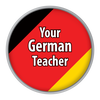|
In this video you can actively practice and see if you know when to use the auxiliary verb SEIN and when HABEN to form prefect tense. This exercise consists of 15 sentences in perfect tense that not only include the most important past participles of verbs that form perfect tense with SEIN but also some participles of verbs that are often mixed up. More important videos about this topic and explanations for the grammar part you can find below in this description.
1 Comment
In this video you will learn how to form AND when to use the German demonstrative pronouns "dieser, dieses, diese...". Together with example sentences and questions and answers you can practice along with me. In German they are called "Demonstrativpronomen" and mostly used in situations when you can point at something or somebody. There are some VERBS that require DATIVE case. And in this lesson you have the chance to practice the most important ones for A1 along with Personal Pronouns in accusative & dative. The first exercise is exclusively about A1 dative verbs, while the second exercise also requires the knowledge of personal pronouns in accusative and dative. Therefore this lesson is based on our videos "Verben Mit Dativ A1" , "German Personal Pronouns in Dative" and "German Personal Pronouns in Akkusativ". In case you haven't learnt or struggle with either one of these topics we recommend to watch the applicable video before you start this exercise. Do you also have this problem? Welcher, welche, or welches... when do you have to use which? In this video you will learn when, why and how you have to use the correct ending for the right situation. The question word welch... is a very common used way to ask a question in daily German language. What else you can use it for you will learn at the end of the video in the bonus tips. The verbs STELLEN | LEGEN | STEHEN | LIEGEN cause a lot of confusion and are often used the wrong way. So we decided to create a lesson that gives you the chance to practice those four verbs and the prepositions that they come with. In the first section of this practice video you will get a very brief review/explanation when to use which verb, followed by multiple-choice questions. You will not only have to choose the correct verb but also need to put it into the right form. The second part is about choosing the right preposition and case for each sentence. Like in section one you will get a short review/explanation when to use which case. In this video you will learn or get to know all A2 German reflexive verbs (Reflexive Verben). With prepositions and example sentences. The bonus tip is about some idioms and phrases which are used together with reflexive verbs. DASS is definitely one of the most important and most often used conjunctions in German language. In this lesson you will not only learn how to form a proper sentence with the conjunction DASS, but also when to use it. This video is intenionally keep very simple to make it easy for you to learn the basics about this conjunction without any unnecessary confusing knowledge that doesn't match your German level (A2). In the Tips & Tricks section I will also point out the diefference between DASS and DAS. Last but not least there is also some homework to practice a bit the conjunction DASS. Do you also have this Problem? When you see dates in German: Which ending do you have to use? -te / -ten / -ter??? Which one is correct? Dont't worry... 😉 In this video you will learn how to say German dates correctly and also understand why there are those endings. Of course you can always memorize these few endings and in the beginning it's maybe also the better choice. But as an intermediate student you should try to understand the endings: why they are there and when you have to use which. More about this topic in the bonus tip of this video here. In this video you will learn how easy it is to use the conjunctive adverb "DESHALB" to connect two sentences. Besides the most common sentence structure and lots of examples I will also show you the difference between "DESHALB" and "WESHALB" in the BONUS TIP of this video. To make sure you know it all, I also included the most often used SYNONYMS for "DESHALB". In case you want to see if you got it all right, you can leave us a comment and answer the question at the end of the video in the Bonus Tip. In this video you will learn all German reflexive verbs you need to know for A1 level. Even though the reflexive verbs are usually taught in A2 level in most German textbooks; they still are used also on A1 level. Therefore it's worth learning those verbs and try to understand their concept already from the beginning. They are common used verbs and sometimes have different meanings. But more about those exceptions in this video's bonus tip. 😉 |

 RSS Feed
RSS Feed
